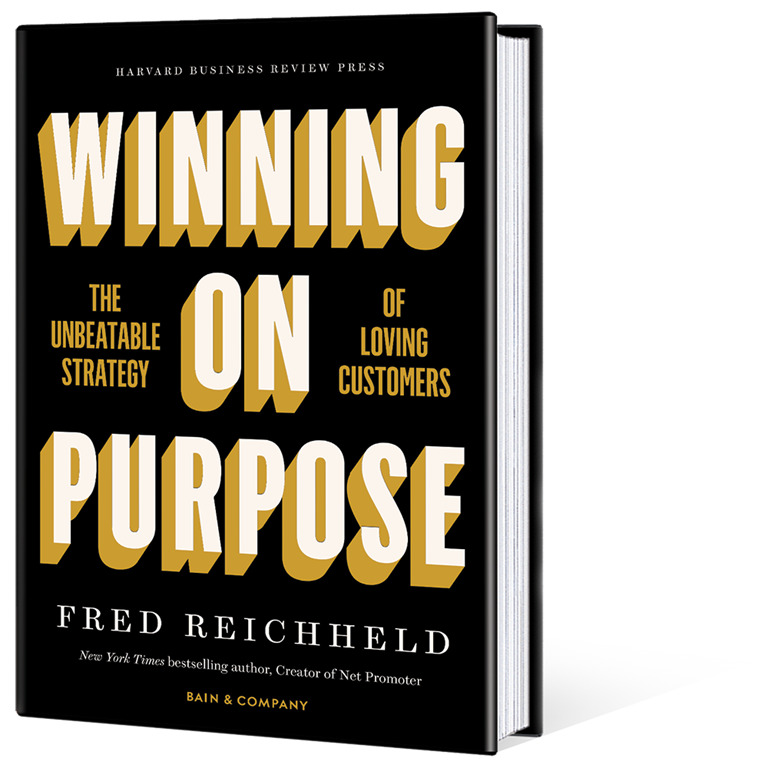You can listen to this episode and others on Apple Podcasts, Spotify, Stitcher, or your podcast provider of choice.
With their often-streamlined operating models, digital native insurgents have placed many industries under attack. Such models grant them clear visibility into customer happiness, allowing them to easily identify opportunities to improve customer relationships.
Incumbents, however, have often been weighed down by operational hurdles and siloed management models, resulting in middling NPS for years. But many leaders see insurgents’ strategies and methods out of reach for them. Maureen Burns, a Bain Partner and coauthor of the new book Winning on Purpose: The Unbeatable Strategy of Loving Customers, says they shouldn’t despair.
“I like to say nice guys and gals finished first, and it’s really true,” she says. “And it’s exciting for me to be able to tell that to executives and give them the confidence that they can deliver for customers like insurgent brands do.”
The key, says Maureen, is to learn from insurgent brands and, over time, use similar methods to transform your business until it truly centers around customer satisfaction. The result? Happier customers and satisfied shareholders.
“There is no conflict between doing good for customers and employees and doing amazingly well for shareholders,” Maureen explains. “I think that many executives see this false trade-off between making the decisions that are going to help them deliver for customers and employees and drive shareholder return.”
The road to such a customer-centered strategy is not an easy one. Maureen says it relies on a company’s willingness to invest in and undergo a significant transformation, often reconstructing their data collection and sharing methods and reorienting customer-centered accounting.
But companies that do invest, according to Maureen, set themselves up for long-term, sustainable success with both customers and shareholders.
“Always putting the customer first, inherently first, like really giving them more value and making their lives better, is actually the most sustainable way to drive out performance,” she says.
In this episode, the second in a series with the authors of Winning on Purpose, Maureen and I discuss the indisputable value of a truly customer-centric strategy, why it is so hard for big companies to actually deliver, and how those hurdles can be overcome.
Learn more about Winning on Purpose and purchase a copy here.
In the excerpt below, Maureen and I discuss the benefits of the earned growth model of accounting and how companies can use it to gauge customer happiness.
Maureen Burns: One of the things that we’ve talked about in the book is this concept of earned growth. So, looking at how much of your growth is coming from existing customers, buying more and referring vs. bought through marketing. So simple concepts like that I think are important. Because if you think about it, it is really retention, share of wallet referrals, and paid marketing.
So really, the components of customer acquisition costs. So, if you’re looking at these things, it’s a really good way to kind of understand the health of your customer base and the health of your company, ultimately, because really that is what drives growth over the long term.
Rob Markey: As I’ve tried to get my head around this concept of earned growth and not just the high-level version of “It’s important to earn your growth,” which seems to me the healthiest way to grow, but specifically the idea of creating an earned growth rate metric as a way of gauging how the company is doing.
I wonder how you would react to my characterization of it as a measure for quality of earnings or quality of growth.
Maureen Burns: Absolutely. It absolutely is. Because if you think about what we’re saying, and you were the one in one of our conversations that said, “This is really an overarching philosophy of how you run a business,” which is: I am going to earn my growth vs. this constant treadmill of paid marketing to acquire more and more.
I do think it is a very good indicator of the health and quality of your earnings. We also know from all the micro level economics we did at different companies that these earned customers end up having better profiles over time. Right. They end up buying more. They end up having lower cost to serve. They end up referring more. So, we’re kind of calling it the promoter multiplier, and it’s kind of got an exponential effect. When this is your model you are driving growth in a different way than companies that are buying growth. And we believe that this is really the underlying reason that those NPS leaders that you identified have outperformed the market as handily as they have.
And so, it all comes together in a way that says if I can get this mindset and I can really understand that there’s a different way of doing business, that’s how you drive really sustained outperformance.




